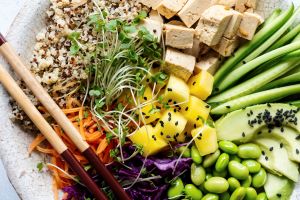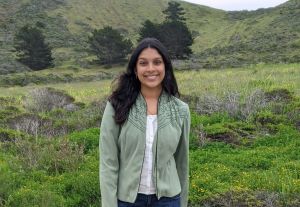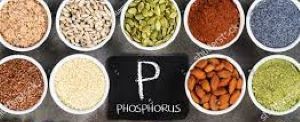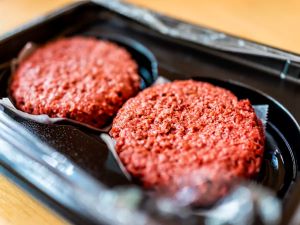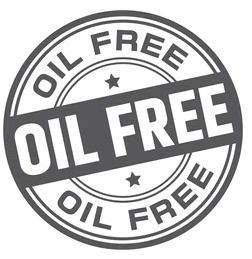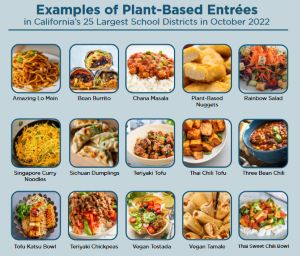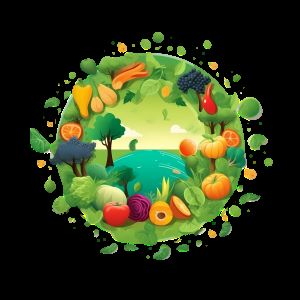Vegan and Vegetarian Summer Camps 9
For other Teen FAQs, visit: http://www.vrg.org/teen/
The last few years I’ve been to summer camp, they always say that vegetarian meals are available. When I get there it is the same foods every night or just a salad bar, veggie burgers, and peanut butter and jelly. Are there any camps that actually have good menu options for vegetarian and vegans?
By Julia Warren
Yes! There are camps out there that offer great vegetarian and vegan options for kids and teens; you just have to look harder. Having a good camp experience is difficult when you are always hungry so finding camps that meet your dietary needs is important. We have made a list of some camps across the United States and Canada that keep in mind their vegetarian campers or are exclusively vegetarian/vegan. If none of these camps are located in your area there are some steps you can take to make sure your local camps are able to provide you with the appropriate food.
- Get in touch with the camp. Email or call the camp director or foodservice director to talk about the specific foods they offer. Many camps have entire menu plans or lists of foods that are available so you can get an idea of what you are looking forward to. Even if they don’t have what you want, a lot of camps aim to please and may be willing to work with you to get you some better options.
- Bring your own foods. Day camp? See if you can bring your own lunch. Overnight camp? See if there is a place where you can store food that you bring if they cannot guarantee appropriate foods. That way you know you’ll get something you will like and can eat.
- Be creative and try new things. Look at new combinations of foods. Never put edamame in your salad? Ever heard of sunflower seed butter? Camp may be the time to try something different!
Vegan Camps
Camp Exploration
Tarzana, CA
100% Vegan! Sessions focus on a wide range of topics. Camping in Zion and Bryce National parks, visiting alien/space related sites, traveling the California coast, and hiking Yosemite are some of the programs available each summer.
A wide range of vegan foods are available for both the vegan and non-vegan camper. Campers even have the opportunity to help prepare the food. Menu items include:
- Fondue
- Veggie sushi
- Vegan lasagna
- Falafel, hummus, babaganoush, tabouli, dolmas
- Smoothies
- Scrambled tofu
- Veggie jerky
- Toasted vegan marshmallows
- Stuffed peppers
- Mac and uncheese
- TLT’s (tofu, lettuce and tomato)
Contact Info
Address: PO Box 572572
Tarzana, CA 91357-2572
Phone: (818) 344-7838
Email: [email protected]
www.CampExploration.org
www.VeganCamp.org
www.kidsla.org/camp
Youth Empowered Action (YEA) Camp
Santa Cruz, CA; Portland, OR
Leadership/Activism Camp for ages 12-17. Campers look into issues like animal cruelty, violence, and gay marriage and develop the knowledge and skills required to advocate for change in issues that interest them.
Organic, vegan meals, using mostly local foods are provided for campers.
Before you go, inform them of allergies and special dietary needs so they can make sure they are properly supplied. Sample menu items include:
- Breakfast: French toast, pancakes, bagels
- Lunch: teriyaki rice bowls, falafel, barbecue tofu
- Dinner: veggie curry with coconut rice, stuffed shells, pizza
- Desserts: chocolate chip cookies, brownies, ice cream sundaes
- Snacks: popcorn, pretzels, fresh fruit
Contact Info
Location:Santa Cruz, CA
Phone: (415) 710-7351
Website: www.yeacamp.org
Email: [email protected]
Location: Portland, OR
Phone: (503) 347-0223
Website: www.yeacamp.org
Email: [email protected]
Location: Lanoka Harbor, NJ
Phone: (503) 347-0223
Website: www.yeacamp.org
Email: [email protected]
Vegan Camp at the Sthitaprajna Vegan Retreat
Karnataka, India
This is a camp for adults that provides a place for relaxation, meditation, Yoga, and vegan living. Beach and village visits as well as hiking and other day trips are included.
The entire retreat center is vegan; no animal foods, silk or leather are allowed and smoking and alcohol are prohibited.
Contact Info
Email: [email protected]
http://indianvegansociety.com/vegan_centre
Vegetarian Camps
Hawthorne Valley Farm Camp
Ghent, NY
Hawthorne Valley is an agricultural camp that teaches about sustainable agriculture and husbandry.
Vegetarian meals focus on biodynamic/organic, local foods. Eggs and dairy products are produced at the camp and are used along with whole grains, and seasonal foods in making all the meals from scratch.
Contact Info
Address: 327 Route 21C, Ghent, NY 12075
Phone:(518) 672-4790
Fax:(518) 672-7608
Email: [email protected]
www.vspcamp.com
Common Ground Center
Starksboro, VT
Common Ground center is a family camp with programs for families with children and teens. During each session programs are offered each day specifically for teens, children, and parents separately. Group activities are scheduled for evenings.
Vegetarian meals are provided and have an emphasis on organic and local foods. They can accommodate special diets and have vegan options available. Indian night, falafel, and Asian night are some popular and entirely vegan dinners offered.
- Full salad bar daily
- Fresh brick oven bread/pizza baked on premise
- Healthy snacks always available
Contact Info
Location: Starksboro, VT
Phone: 1-800-430-2667
www.cgcvt.org
Camp Woodbrooke
Richland Center, WI
Quaker- based camp for youth of all ages that includes an emphasis on community service, cooperative decisions, and fun.
This family run camp is vegetarian and vegan (meat options are by request). Many of the meals use produce from the camp garden and are made from scratch. Some examples of foods served are:
Vegan
- Falafels
- Spaghetti
- Potato Leek Soup
- Lentil Soup
- Pancakes, biscuits, coffee cake, muffins, cobblers (vegan versions)
Vegetarian
- Quiche
- Calzones
- Enchiladas
- Sandwiches with homemade bread (cheese, hummus, avocado)
Contact Info
Corporate Address: 1704 Roberts Ct, Madison, WI 53711-2029
Phone: (800) 498-9703
Email:[email protected]
www.campwoodbrooke.org
Camp Frenda
Port Carling, ON, Canada
This is a Seventh-day Adventist camp. Horseback riding and waterskiing are two main activities that are offered in addition to the usual camp programs.
All meals are vegetarian. Sample menus include:
- Sabbath Fixed Continental Breakfast: Muffins/Pastries, Bagels and Cream Cheese, Hard Boiled Egg, Hot and Cold Cereals, 2% Milk and Soy Milk, Fresh Whole Fruit & Canned Fruit, Whole Wheat Bread, Juice ‘n hot drinks
- Sabbath Lunch Menu: Lasagna, Garlic Bread, Corn , Salad Bar, Apple Crisp
- Sabbath Dinner Menu: Haystacks, Chips, Chili beans, Soup, Fresh whole fruit
Contact Info
Phone: 705-765-5597
Fax: 905-571-4781
Email: [email protected]
Email(foodservice director):[email protected]
www.campfrenda.com
Good Vegetarian Options Available
Camp Alonim
Brandeis, CA
Learning about Jewish heritage and Israeli life is the basis of this day camp and overnight camp. Swimming, photography, a climbing wall, horseback riding, and mountain biking are some of the activities for campers. Israel Day and Israeli dancing allow children to learn and celebrate the culture of Israel.
The camp has an organic garden and also offers cooking classes. Vegetarian options include:
- Spaghetti and marinara sauce
- Tofu chicken nuggets
- Tempura
- Vegetable bourekas
- Kugel
- Vegetable pot pie
- Grilled cheese sandwich
- Vegetable cholent
- Cheese quesadillas
Contact Info
15600 Mulholland Dr., Brandeis, CA 93064
Phone: 877-2-ALONIM
Fax: 877-856-3250
Email: [email protected]
www.alonim.com
Arrowbear Music Camp
Running Springs, CA
Musical instruction at varying levels is combined with nature explorations, group activities like volleyball, swimming, and crafts. Sessions end with a camp-wide concert open to family members to showcase the campers’ hard work and practice. Sample menu items include:
- Breakfast: Eggs & hash browns, melon, cereal (soymilk), oatmeal, juice,hot cocoa
- Lunch: Grilled cheese sandwiches, tomato soup, celery, carrots, fruit (Vegan: grilled
cheese with nutritional yeast & avocado) - Dinner: Homemade pesto over pasta with tomatoes (Vegan pesto made without cheese), sautéed squash, lemon squares
Contact Info
P.O. Box 180 Running Springs, CA 92382
Fax: 909-867-2794
Phone: 909-867-2782
Email: [email protected]
www.arrowbear.com
Camp Winacka/ Whispering Oaks
San Diego Girl Scouts Camps, San Diego, CA
Under the Girl Scout Council two camps are available. Camp themes cover a range of topics and activities. Some of the sessions include learning how to blog and web design, horseback riding, sewing, backpacking, culinary arts, jewelry making and wilderness adventure.
Both camps provide numerous options for vegetarians and vegans. To begin with, many meals are designed to be vegetarian. Vegan options are always available and many times the main meals can easily be altered to avoid dairy and eggs. One example is stir-fry; the vegetable are cooked separate from any meat so that everyone can eat them. The cooks work to create meals that work seamlessly with what the majority of the camp is eating.
Sample menus include:
- Breakfast: Pancakes (vegan pancakes are available), Yogurt, Veggie Sausage, Fresh Fruit, Hot Cocoa
- Lunch: Build-Your-Own Taco Salad: Tortilla Chips, Salsa, Lettuce, Beans, Sour Cream, Cheese; Celery and Broccoli; Cinnamon Sugar Cookies (alternative vegan dessert example: ices)
- Dinner: Pasta, Marinara Sauce (meatless), Garlic Bread, Roasted Carrots, Salad, Chocolate Cake (alternative vegan dessert)
Contact Info
1231 Upas St, San Diego, CA, 92103
Phone: 800-643-4798
Email: [email protected]
www.sdgirlscouts.org
Camp Toccoa
Tocca, GA
Camp Tocca offers a traditional summer camp for youth along with climbing, adventures and horseback riding sessions.
There is always a meatless version of the main dish available for vegetarians. Children who are vegan or who have dairy allergies will be provided alternatives as well. Soy products are common replacements for meat in many of the dishes. Grains and beans are also used. They say, “We DON’T assume that our vegetarian and vegan campers will be happy eating lettuce for a week.”
Contact Info
92 Camp Toccoa Drive, Toccoa, GA 30577
Phone: (706) 886-2457
Fax: (706) 886-5123
Email: [email protected]
www.camptoccoa.org
Camp Emerson
Hinsdale, MA
Campers, age 7-15, design their own schedules from over 50 different activities. Categories include sports, performing arts, water sports, wilderness, studio arts, science and cooking.
The owner is vegan and provides an extensive menu for vegans and vegetarians. Camp Emerson is also expert at food allergies, Celiac Disease and intolerances. A team of Registered Dietitians and Specialty Chefs are employed by the camp to ensure that children with allergies eat safely. The camp is peanut, treenut, sesame and shellfish free. Sunflower seed butter is always available instead of peanut butter. The priority is delicious meals and full inclusion.
Cooked from scratch, healthy vegetarian & vegan meals are offered each day. There are always alternatives:
- Extensive salad bar daily (hummus, tofu, avocado, cheese, sunflower seeds, etc)
- Variety of sauces and a pasta bar
- Meatless alternatives
- Plant based milks and cheese
- Soy alternatives
- Gluten-free alternatives
Contact Info
Phone: 800-782-3395
Email: [email protected]
www.campemerson.com
Camp Sabra
Rocky Mountain, MO
Traditional camp activities and Jewish traditions combine at Camp Sabra. The camp offers activities like sailing, waterskiing, wake boarding, high/low ropes course and videography. Israel Day allows children to learn about their heritage and a Shabbat service is held each Saturday.
The camp keeps a kosher kitchen and offers vegetarians a full salad bar daily with hummus and sunflower seed butter as well as other options.
Contact Info
30750 Camp Sabra Road, Rocky Mount, MO 65072
Summer Phone: 573-365-1591
Summer Fax: 573-365-0577
Winter Phone: 314-442-3151
Email: [email protected]
www.campsabra.com
North Country Camps
Keeseville, NY
Nature programs, mountain biking, rock climbing, art & crafts, and sports are everyday activities available to campers. Special programs for wilderness overnight trips, work groups, and even 4-5 week expedition trips are also associated with the camps.
The kitchen staff prepares a number of soups, casseroles, stews, wraps and tofu dishes for vegetarians throughout the summer. Every year they host between 40-50 vegetarian campers and staff. Vegan alternatives may be limited.
Contact Info
Phone: 802-235-2908
Email: [email protected]
www.northcountrycamps.com
Journey’s End Farm Camp
Sterling, PA
Campers learn about farming and husbandry at this camp. A combination of work and play has created their philosophy know as “plork.” Campers get chance to milk a cow, pick berries, harvest vegetables, and bake. Swimming, ceramics, sports, campfires and cookouts are other typical activities that are incorporated into camp sessions.
Journey’s End Camp works creatively to incorporate seasonal produce, grown on the property, into every meal. They offer options for vegetarians and vegans and will work with campers to ensure that everyone is satisfied (gluten-free options are available as well).
- Quiche
- Veggie Lasagna/Pizza (vegan option: pesto with pasta or on crust with tofu “cheese”)
- Lentil soup with carrots and curry flavoring with homemade French bread
- Zucchini stuffed with rice/egg/vegetable/bread crumbs with cheese (vegan alternative)
- Pasta Salad with chopped vegetables and vinaigrette
- Salad available at lunch and dinner daily
Contact Info
P.O. Box 23, Sterling, PA, 18463
Phone: 570-689-3911
Email: [email protected]
www.journeysendfarm.org
Camp Tonkawa
Collinsville, TX
Nature Awareness Center for Adults and Children that focuses on connecting with nature and developing survival skills in a creative, fun, learning environment.
Every meal has a “no meat” option; foods are prepared separately and combined just before eating so animal products can easily be omitted in many of the meal options. Artificial colorings, additives, sweeteners and white sugar and flour are used sparingly or not at all. Those with very specific food allergies may want to provide their own alternatives for foods.
Contact Info
Phone: (940)440-8382
Email: [email protected]
www.camptonkawatexas.com
Global Youth Village
Bedford, VA
This is an International Leadership Camp that focuses on global involvement. Campers participate in activities like debate, listening skills, improving communication, and peace building. This is in addition to more traditional camp activities with global flair (ex: Turkish tilemaking, clogging with the Hoorak Cloggers, African drumming, Urkranian egg painting, etc)
Vegetarian meals, use mostly unprocessed fruits, vegetables, whole grains, and honey. Entrées from countries around the world, including Greece, the Middle East, India, Japan, and Nigeria are offered regularly.
Contact Info
1020 Legacy Dr., Bedford, VA 24523
Tel: 540-871-0882
Fax: 540-297-1860
http://globalvillage.org
Written by Julia Warren
Julia collected the information used in this article during a distance internship with The Vegetarian Resource Group. She will be entering her final year as a nutrition major at the State University of New York at Plattsburgh.
The contents of this article and our other publications, including Vegetarian Journal, are not intended to provide personal medical advice. Medical advice should be obtained from a qualified health professional. We depend on information from camps, websites, or third party sources. It is impossible to be 100% sure about a statement, info can easily change, people have different views, mistakes can be made. Please use your best judgment about whether a camp or food is suitable for you. Please do further research or confirmation on your own. Let us know about positive vegan experiences you have with these or other camps. Comments can be sent to [email protected].
